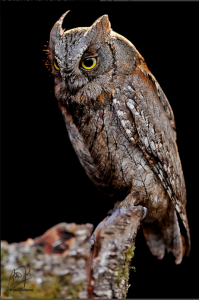Here you will find all the nocturnal raptors of Extremadura
Eurasian eagle-owl Bubo bubo

Of all the nocturnal raptors of Extremadura, this is the largest. It has terribly strong claws and can wipe out prey the size of a rabbit or a hare in seconds. The eagle owl lives on the slopes of Mediterranean forests with the presence of stone cuttings where it usually nests. It makes long journeys in its nights of hunting in which it captures all kinds of animals, even diurnal raptors or small foxes. Like all super predators, its densities are not high, but Extremadura has some very interesting populations. The best areas to observe it being the Sierra de Tiros, central mountains of Badajoz, San Pedro, Orellana, Villuercas, Llanos de Cáceres, Monfragüe, Canchos de Ramiro and Tajo Internacional.
The Canal de las Dehesas that borders Orellana lake is an excellent place to spot it.
Little owl Athene noctua

Small-sized bird of prey, mainly nocturnal but also twilight habits. We can observe it in oak groves, olive groves and cultivation areas where it mainly feeds on invertebrates. It is often seen in dry trees, semi-ruined buildings from which it starts its nocturnal excursions. Relatively abundant, we can also locate it by its characteristic song at nightfall. It is present throughout the region all year round.
Long-eared owl Asio otus

Medium sized nocturnal bird of prey, with large ear-like plumes, nests on large tree trunks. Exclusively nocturnal, it feeds mainly on mice and voles but occasionally on small birds as well. It is a forest bird and is present in forests of all species: holm oaks, cork oaks, oaks, conifers, riverside forests… In winter many Central European individuals migrate to Extremadura, grouping together in roosts, despite being normally solitary individuals. Present throughout the community, we could highlight the meadows of La Campiña Sur and La Albuera, and the forests of Sierra de Gata for their difficult sighting.
Scops owl Otus scops

The Scops Owl is the smallest of the nocturnal raptors of Extremadura, and its plumage blends in perfectly with the trunks of the trees in which it lives. It’s very woodlander, although we can also find it in large urban parks. It feeds on small invertebrates such as grasshoppers, crickets, moths… and we can detect their presence by their song. Present in Extremadura in spring and summer, it migrates to Africa in the coldest months. Although we can find it all over the region, the area of Valle del Jerte stands out for its populations.
Short-eared owl Asio flammeus

Also of medium size, it stands out for the intense yellow color of its eyes. With very different habits to the previous ones, it mainly inhabits cereal fields and marshy vegetation areas, nesting on the ground. It feeds mainly on small rodents and sometimes starts hunting at sunset, which is the best time to observe it. Some individuals reproduce in the region although the bulk of the population winters. Their populations are very fluctuating as they move around quite a bit depending on the voles’ population explosions.
Tawny owl Strix Aluco

Similar in size to the barn owl, but with much more mimetic colours to the forests in which it lives. All kinds of forests, wooded banks and even urban parks are its habitat, although it is less linked to human presence than the barn owl. It feeds mainly on rodents but also on small birds or invertebrates and denotes its presence by its characteristic wailing at nightfall. It is abundant in Dehesas de Jerez, the area of La Albuera, Villuercas, San Pedro, Gata, La Vera and Valle del Jerte.
Wester barn-owl Tyto alba

A very cosmopolitan bird of prey, probably the most abundant of the nocturnal raptors of Extremadura, it usually nests in churches, farmhouses and other buildings. It usually feeds on small rodents but can also hunt small birds in their sleep. Present throughout the region, its populations have been clearly declining for decades. This regression is mainly due to modern agricultural practices (monoculture, use of pesticides, etc). Active from dusk onwards, the best places to see it are the populations themselves, especially those with large stone buildings and located in cultivated areas.
Thanks to Ángel P. Cañones, Isaac Fernández Galisteo and Mariano Cordero for the pictures.





